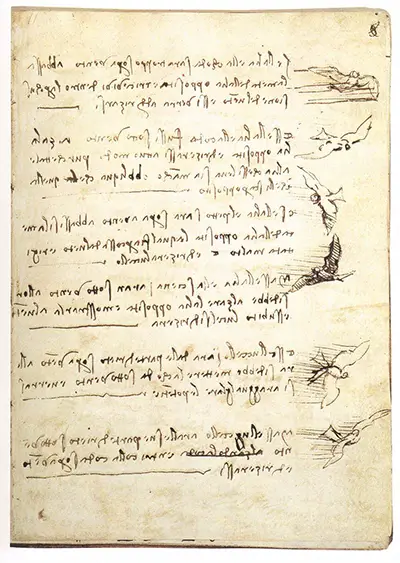Codex on the Flight of Birds
The Codex on The Flight of Birds by Leonardo Da Vinci is known as one of the greatest documents for helping spectators to understand the inner workings of the great man’s mind. The codex is a piece of work comprising of 18 folios, measuring 21 x 15 cm.The folios take the observer on a journey of bird flight and the beginnings of the development of flight machines. As well as ideas for flight using machinery the later folios also document some key principles of physics, that at the time of the folio’s creation had not been discovered.
Da Vinci was extremely forward thinking in his approach to life and he endeavoured to be in a position to fully understand the world around him. Throughout his lifetime he created thousands of notebook pages, put together in codices. These documented lots of the artist's thoughts on findings on topics such as engineering, anatomy, military technology and geology. Leonardo was ahead of his time and these codices helped mankind to develop in lots of different areas even after his death.
Da Vinci’s Codex of the Flight of Birds will perhaps, be his most remembered codex, however, because it sowed the seeds for mankind to develop the gift of flight, which has radically changed our world. Leonardo’s obsession with human flight would never be realised in his lifetime but his notes and drawings inspired the work of pioneers such as the Wright Brothers as they developed the first flying machine hundreds of years after his death.
The codex, itself is logical in its approach. Leonardo sought to fully understand the mechanics of bird flight in order to theorise how it could be replicated with machinery. In the document, he demonstrated his understanding of the force known as lift and the role that this plays in flight. He also discovered the role of thrust, through his realisation that the flapping of birds’ wings did not contribute much to lift and that the action actually created a force that pushed the bird along in flight.
The codex begins with the analysis of bird flight and details all of Da Vinci’s findings in regards to the physics of this action. It then goes on to use these findings to start to design flying machines, some of which are not too dissimilar to machines that we use today, certainly, one drawing remarkably resembles a modern helicopter. It is also thought that Da Vinci did construct some of the machines pictures in the codex and attempted to fly them off a hill in Florence but without success.
The Codex of the Flight of Birds, created between 1505 and 1506 is housed in the Royal Library of Turin but occasionally it is loaned out to exhibitions around the world. If you do get the chance, it is a really incredible opportunity to see this fascinating glimpse into the mind of this legendary man.


